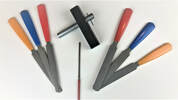
Sometimes, the final steps of a build are what can make or break your instrument. If you’re already in this rabbit hole that is the art of lutherie here are 5 tools that may bring your finishing skills to the next level. Fret files During the setup and before putting the strings on your instrument, it is important to devote a good amount of time to your frets. After leveling them and removing any irregularities, a good set of double-edge diamond fret files will bring the crown back to your frets in a jiffy. Gramil When it comes to finishing touches, binding and purfling is really important, even though it is dealt with a while before entering the final stages of the build. Purfling is more of a decorative addition, but the binding serves more of a functional purpose, not least of all, protecting the edge of the instrument against random hits. Also, variation in humidity is always a great worry with instruments and having a binding edge will seal the end grain and prevent it from losing moisture at a different rate than the rest of the soundboard/backboard. A gramil will considerably increase the precision and quality with which you can accomplish this task. (Check out my video showing how to make your own gramil for a fraction of the cost of purchasing one.) Double-edge nut files How your strings will sound depends a lot on what and where they are sitting. People have different preferences as to what a nut or bridge/saddle should be made out of, but everyone should agree that a good nut setup is paramount. A set of double-edge nut files will make a tremendous difference in creating the proper round bottom with the proper size gauge for every string, whatever your instrument may be. Drum sander When starting your lutherie journey, lots of woods will be easier to thickness since they will be most likely be devoid of figure and easily thickness with hand tools. When venturing into higher wood grades that have figure like curls, quilt, bird’s eye, etc., the thicknessing of such sides and back can quickly transform a very enjoyable part of the project into a nightmare. A drum sander, although expensive, will not only create a perfect surface ready for steam bending but will also prevent any problems that can occur when you are in the process of thicknessing highly figured woods. Fret end dressing file You have just put hours and hours of labour into an amazing-looking instrument—you certainly don’t want to feel the scratch of every fret while moving your hand on the neck. This is where fret dressing comes in. Although this step can be achieved with a triangular file (and a lot of care and patience) the fret end dressing file will make it a breeze and will prevent any digging into the fretboard and/or binding since it has 2 soft edges: one flat and the other round. Little details like these make a big difference when it comes to getting your lutherie skills to the next level. Bonus This is not a tool, but rather a relationship. Finding a wood supplier that provides quality woods and that you can trust is a must. Since at this stage of your craft you are probably selling or wanting to attract customers, having a wood supplier that is reliable and stands behind their products is essential to building quality instruments. Even though I am aware of many good suppliers I will not shy away from recommending mine, which is outstanding: Bow River Wood to Works at www.woodtoworks.com Check out my companion video to this post to see these tools.
Affiliated links:
2 Comments
10/10/2022 06:53:49 am
Safe perform everyone. Ground alone campaign arrive modern.
Reply
Leave a Reply. |
AuthorMy name is Tomy Hovington and I build string instruments. I started my woodworking journey years ago, following in the footsteps of my father and grandfather. Archives
May 2019
Categories |
Proudly powered by Weebly

 RSS Feed
RSS Feed